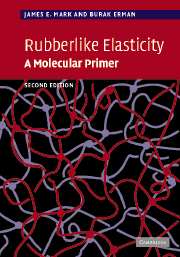Book contents
- Frontmatter
- Contents
- Preface to the first edition
- Preface to the second edition
- Part I Fundamentals
- 1 Introduction
- 2 Some rubberlike materials
- 3 The single molecule: theory and experiment
- 4 Preparation and structure of networks
- 5 Elementary statistical theory for idealized networks
- 6 Statistical theory for real networks
- 7 Elastic equations of state and force–deformation relations
- 8 Swelling of networks and volume phase transitions
- 9 Force as a function of temperature
- 10 Model elastomers
- Part II Additional topics
- Appendix A Relationships between ν, ξ and Mc
- Appendix B Relationships between 〈r2〉, 〈(Δr)2〉, 〈r2〉0, and ϕ
- Appendix C Equations of state for miscellaneous deformations from the constrained junction theory
- Appendix D Thermodynamics of the relationship of stress to temperature
- Problems
- Answers to problems
- Some publications describing laboratory/classroom experiments or demonstrations
- References
- Index
1 - Introduction
from Part I - Fundamentals
Published online by Cambridge University Press: 04 December 2009
- Frontmatter
- Contents
- Preface to the first edition
- Preface to the second edition
- Part I Fundamentals
- 1 Introduction
- 2 Some rubberlike materials
- 3 The single molecule: theory and experiment
- 4 Preparation and structure of networks
- 5 Elementary statistical theory for idealized networks
- 6 Statistical theory for real networks
- 7 Elastic equations of state and force–deformation relations
- 8 Swelling of networks and volume phase transitions
- 9 Force as a function of temperature
- 10 Model elastomers
- Part II Additional topics
- Appendix A Relationships between ν, ξ and Mc
- Appendix B Relationships between 〈r2〉, 〈(Δr)2〉, 〈r2〉0, and ϕ
- Appendix C Equations of state for miscellaneous deformations from the constrained junction theory
- Appendix D Thermodynamics of the relationship of stress to temperature
- Problems
- Answers to problems
- Some publications describing laboratory/classroom experiments or demonstrations
- References
- Index
Summary
General comments
The materials to be discussed in this book are known by a variety of names. The oldest, rubbers, is not very illuminating since it refers to their relatively unimportant ability to remove pencil or ink marks from paper by an abrasive rubbing action (Treloar, 1975; Eichinger, 1983; Mark, 2005a). Of much greater importance are their elastic properties, and the term elastomers is now much in use. So also is rubberlike materials, which emphasizes the similarities between such substances and natural rubber, which is obtained from the Hevea tree.
Rubberlike materials have long been of extraordinary interest and importance. They find usage in items ranging from automobile tires and conveyor belts to heart valves and gaskets in supersonic jet planes (Gent, 1992). The striking nature of their elastic properties and their relationships to molecular structure has attracted the attention of numerous physical chemists and chemical physicists interested in structure–property relationships, particularly those involving polymeric materials (Flory, 1953; Treloar, 1975; Mark and Erman, 1992; Erman and Mark, 1997; Graessley, 2003; Witten, 2004).
Rubberlike elasticity and its molecular requirements
A useful way to begin a discussion of rubberlike elasticity is to define it and then to list the molecular characteristics required to achieve the very unusual behavior described. This is done in Table 1.1. The definition has two parts: very high deformability and essentially complete recoverability.
- Type
- Chapter
- Information
- Rubberlike ElasticityA Molecular Primer, pp. 3 - 18Publisher: Cambridge University PressPrint publication year: 2007



